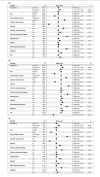Long Covid: a global health issue - a prospective, cohort study set in four continents
- PMID: 39433402
- PMCID: PMC11552006
- DOI: 10.1136/bmjgh-2024-015245
Long Covid: a global health issue - a prospective, cohort study set in four continents
Abstract
Introduction: A proportion of people develop Long Covid after acute COVID-19, but with most studies concentrated in high-income countries (HICs), the global burden is largely unknown. Our study aims to characterise long-term COVID-19 sequelae in populations globally and compare the prevalence of reported symptoms in HICs and low-income and middle-income countries (LMICs).
Methods: A prospective, observational study in 17 countries in Africa, Asia, Europe and South America, including adults with confirmed COVID-19 assessed at 2 to <6 and 6 to <12 months post-hospital discharge. A standardised case report form developed by International Severe Acute Respiratory and emerging Infection Consortium's Global COVID-19 Follow-up working group evaluated the frequency of fever, persistent symptoms, breathlessness (MRC dyspnoea scale), fatigue and impact on daily activities.
Results: Of 11 860 participants (median age: 52 (IQR: 41-62) years; 52.1% females), 56.5% were from HICs and 43.5% were from LMICs. The proportion identified with Long Covid was significantly higher in HICs vs LMICs at both assessment time points (69.0% vs 45.3%, p<0.001; 69.7% vs 42.4%, p<0.001). Participants in HICs were more likely to report not feeling fully recovered (54.3% vs 18.0%, p<0.001; 56.8% vs 40.1%, p<0.001), fatigue (42.9% vs 27.9%, p<0.001; 41.6% vs 27.9%, p<0.001), new/persistent fever (19.6% vs 2.1%, p<0.001; 20.3% vs 2.0%, p<0.001) and have a higher prevalence of anxiety/depression and impact on usual activities compared with participants in LMICs at 2 to <6 and 6 to <12 months post-COVID-19 hospital discharge, respectively.
Conclusion: Our data show that Long Covid affects populations globally, manifesting similar symptomatology and impact on functioning in both HIC and LMICs. The prevalence was higher in HICs versus LMICs. Although we identified a lower prevalence, the impact of Long Covid may be greater in LMICs if there is a lack of support systems available in HICs. Further research into the aetiology of Long Covid and the burden in LMICs is critical to implement effective, accessible treatment and support strategies to improve COVID-19 outcomes for all.
Keywords: COVID-19; Cohort study; Epidemiology; Global Health; Public Health.
© Author(s) (or their employer(s)) 2024. Re-use permitted under CC BY. Published by BMJ.
Conflict of interest statement
Competing interests: JTS was Co-Chair of the ISARIC COVID Global follow up group. NL received a grant from the Italian Ministry of Health to support this work and received support from the National Congress of the Italian Society of Anesthesia and Critical Care Medicine SIAARTI for travel and accommodation expenses to attend a meeting. MoH Trustee is a Trustee of Long Covid Support.
Figures




References
-
- Organization WH WHO dashboard. 2023. [3-Nov-2023]. https://tinyurl.com/yck4y6n2 Available. Accessed.
Publication types
MeSH terms
Grants and funding
LinkOut - more resources
Full Text Sources
Medical
